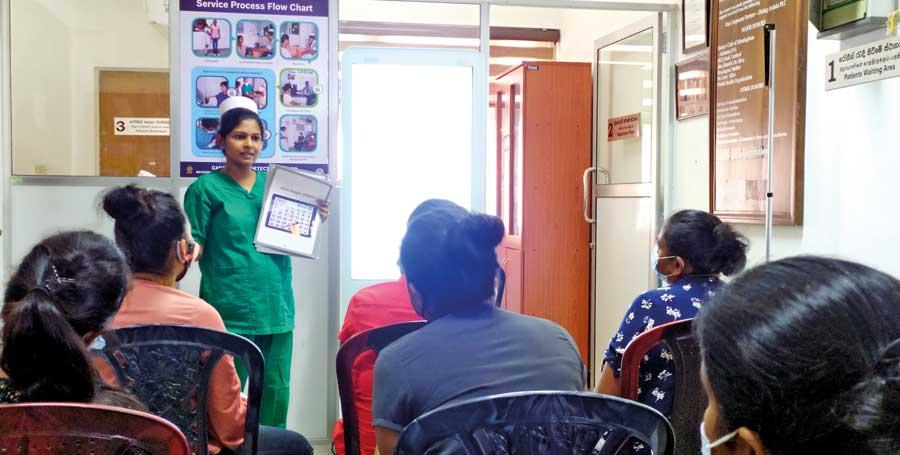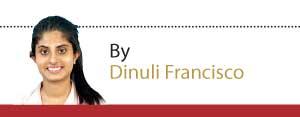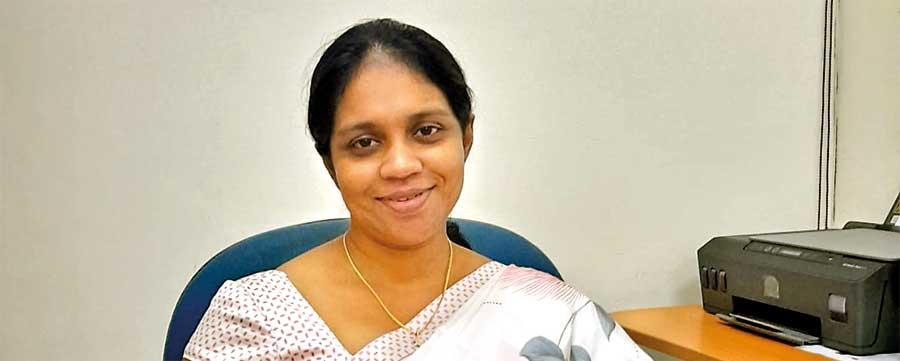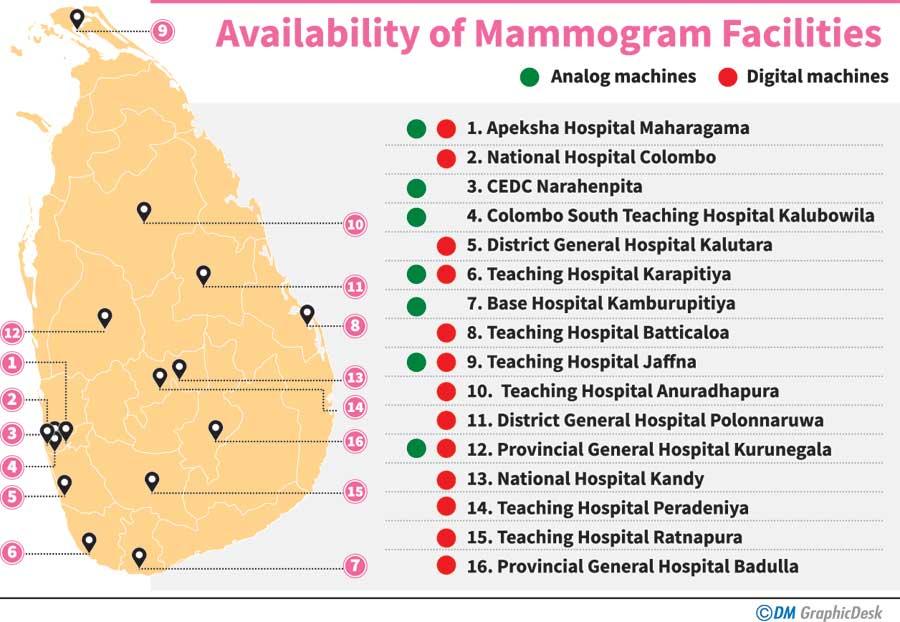Reply To:
Name - Reply Comment

A session on self breast examination at the Cancer Early Detection Centre at Narahenpita
Breast cancer is the most prevalent malignancy in women; affecting one in eight of them at some point in their lifetime. Worldwide, breast cancer still ranks as one of the leading causes of cancer-related deaths.Breast Cancer Awareness Month is observed each October to raise awareness of breast cancer’s risks and challenges, as well as to celebrate advances in prevention, detection and treatment that may one day result in a cure for this deadly condition.
lifetime. Worldwide, breast cancer still ranks as one of the leading causes of cancer-related deaths.Breast Cancer Awareness Month is observed each October to raise awareness of breast cancer’s risks and challenges, as well as to celebrate advances in prevention, detection and treatment that may one day result in a cure for this deadly condition.
Due to the intricate interplay between lifestyle, reproductive and genetic risk factors, breast cancer develops as a result of mutations in breast cells. Ageing, benign breast disorders, lifestyle variables (obesity, drinking, and smoking), reproductive issues, and hormone exposure have all been linked to an increased risk of breast cancer. Family history contributes to 5 – 10% of breast cancer cases, and mutations in the BRCA1 or BRCA2 genes are the most frequent cause of hereditary breast cancer. However, our understanding of the genetic makeup of breast cancer and how it develops are still limited.
Over the past 40 years advances in precision medicine have increased patient survival rates, while innovations in screening techniques like mammography have led to earlier cancer identification. In spite of this, metastatic illness in women is fatal. Additionally, therapy is complicated by global and social inequities, ethnic variances and the molecular complexity of breast malignancies, and many women experience illness recurrence. This necessitates a comprehensive approach to the care and treatment of breast cancer.
The National Cancer Control Programme of the Ministry of Health is the main government organization that coordinates the national response to cancer control activities in Sri Lanka. The objectives of the NCCP are ensuring primary prevention of cancers: that is through cancer early detection centers, advocating for early detection of cancers by improved public health awareness, ensuring rehabilitation, survivorship, and palliative care facilities, and ensuring sustained equitable access to diagnosis and treatment facilities for cancers, strengthening cancer information systems and surveillance, promoting professional educations of healthcare staff, and promoting research in cancer.
The Cancer Early Detection Centre (CEDC) of the National Cancer Control Programme (NCCP) of the Ministry of Health, having a private-public partnership with the Rotary Club of Colombo, has been successfully providing cancer early detection services to Sri Lankans during the past few years.
However, as per internal sources, CEDC has been experiencing a challenge because its mammogram machine has been malfunctioning since last year and is beyond repair. An official of the National Cancer Control Programme, speaking to the Daily Mirror under the terms of anonymity, said that currently, the mammogram machine of the Narahenpita Early Cancer Detection Centre is malfunctioning and that it is a great disadvantage to the patients and to add to that a government sector involvement in this regard wasn’t seen. “A radiographer from the National Hospital of Colombo did the mammograms at the Narahenpita Early Cancer Detection Centre. However, they made visits only two days per week, and only 12 mammogram screenings were done per week. There is a deficiency of radiographers currently at the Cancer Early Detection Centres; notably there being a shortage of female radiographers. In addition, the NCCP had mobile clinics islandwide, but that programme ceases to exist. People in Asian countries are hesitant to visit centres, but when there are mobile clinics in their villages, there is a higher tendency that they come forward and get their tests done,” the official said.
While mammograms can help detect cancer, before that, breast self-exams help to be familiar with how breasts look and feel. So one can reach and alert a healthcare professional if there are any changes in the breasts.
Moving to an overview of the Sri Lankan Breast Cancer situation, according to the NCCP, it is the most common type of cancer among local females. There were around 3,500 new breast cancer cases diagnosed in 2020. In addition, 8 – 10 new cases per day are identified, and the most frequent age for cancer is around age 50. Moreover, the NCCP encourages adult women of all ages to perform breast self-exams at least once a month.
Detecting Breast Cancer Earlier
The Daily Mirror sat with Senior Nursing Officer at the NCCP Thanuja Tharangani Ranasinghe and conducted an interview to delve deeper into the breast self-examination process.
Excerpts of the interview:
QWho should do a self-breast examination?
All women should do a self-breast examination once a month starting from 20 years of age.
Q When should you do a self-breast examination?
It is better to conduct a self-breast examination one week after the start of menstruation (during menstruation, some women feel their breasts painful and lumpy). If you are going through menopause do your examination on the same day every month.
How Should a Breast Self-Exam Be Performed?
1) In the Shower
2) In Front of a Mirror
3) Lying Down
The woman should use two or three fingers, thumb extended, and the delicate palmar pads on the flat, inner surfaces of the fingers for a systematic and attentive feel of the breast in all three techniques. Since fingers are less sensitive and long nails might obstruct hand mobility, it is recommended to use the palmar pads of the finger. Additionally, the breast shouldn’t be squeezed between fingers since this might make the person feel a lump that isn’t actually there.
The self-Breast examination has three components and four steps:
1. LOOK
2. FEEL
3. ACTION
1. LOOK:
Step 1– Begin by looking at your breasts in the mirror with your shoulders straight and your arms on your hips.
Step 2 – raise your arms and look for changes.
Step 3 – While looking in the mirror, look for any signs of fluid coming out of one or both nipples (this could be a watery, milky, yellow fluid or blood).
Step 4 – Next, feel your breasts while lying down, using your right hand to feel your left breast and then your left hand to feel your right breast.
Use a firm, smooth touch with your hand’s first few finger pads, keeping the fingers flat and together. Next, use a circular motion about the size of a quarter. Cover the entire breast from top to bottom, side to side — from your collarbone to the top of your abdomen and from your armpit to your cleavage.
Follow a pattern to be sure that you cover the whole breast. You can begin at the nipple, moving in larger and larger circles until you reach the outer edge of the breast. Following a clockwise pattern could be easy to keep the cycle going so that the person does not forget where she started.
"The mammogram machine of the Narahenpita Cancer Early Detection Centre is malfunctioning"
You can also move your fingers up and down vertically, in rows, as if you were mowing a lawn. This up-and-down approach seems to work best for most women. Be sure to feel all the tissue from the front to the back of your breasts: for the skin and tissue just beneath, use light pressure; use medium pressure for tissue in the middle of your breasts; use firm pressure for the deep tissue in the back. When you’ve reached the deep tissue, you should be able to feel down to your ribcage.
Step 5 - Finally, feel your breasts while you are standing or sitting. Many women find that the easiest way to feel their breasts is when their skin is wet and slippery, so they like to do this step in the shower. Cover your entire breast using the same hand movements described in Step 4.
You should look out for changes in the texture and feel of the breast.
Among the things that should be noted and reported to a physician are:
Consultant community physician Dr. Suraj Perera speaking to the Daily Mirror said that unlike in other countries- where patients above 50 are allowed directly to walk in for mammograms without consultation- here in Sri Lanka, patients are directed for mammograms only when such a test is prescribed by a doctor. “Mammogram machines are not available in every district hospital, and regarding those cases, patients are directed to the surgical unit. In addition, we invite females to do a breast examination by a trained health officer such as a medical doctor, public health nursing sister, public health nursing officer, or midwife available at the grassroots level government sector. The NCCP is of the view that each district must have a Cancer Early Detection Center; therefore, it is important to expand the NCCP,” he added.
The Daily Mirror also spoke with Consultant Community Physician Dr. Hasarali Fernando from the National Cancer Prevention Programme, underscored the importance of early cancer detection and awareness among the community. She said that it is vital to evade the grave consequences of cancer. “All women should be aware of the general changes in their breasts. For example, suppose there is a change in the breast, such as its size, colour, or any nipple discharges like blood or any abnormality, axillary lump or any palpable lump, or any other pain that is experienced other than the pain caused during the menstrual cycle. Generally, menstrual cycle pain is bilateral, but if you have unilateral pain, which means the pain is only in one breast, then you should seek treatment,” she highlighted.

The key message of the NCCP is that early detection is important. If we detect cancer early, it could be treated better. If you come at a late stage of this illness, then the consequences will be bad. Promoting self-breast examinations is also vital. Well Women Clinics and Healthy Life Clinics (HLC) can be visited to obtain more information, and the services are offered free - Dr. Hasarali Fernando, Consultant Community Physician
Regarding breast cancer risk factors, Dr. Fernando highlighted that both modifiable and nonmodifiable risk factors could contribute to the development of cancer cells. He primarily added that by preventing or reducing the risk factors, one cannot reduce the development of breast cancer. “Although there are risk factors, the exact cause cannot be identified; sometimes because there could be multiple risk factors which could be modifiable, and some could be nonmodifiable risk factors. For example, some of the nonmodifiable risk factors of breast cancer are gender, ageing, family history or personal history, early menstruation before the age of 10, and late menopause after 65 years of age. Modifiable risk factors are being overweight and obesity, physical inactivity, unhealthy food consumption, tobacco, and alcohol,” Dr. Fernando said.
“There may be a reduction by controlling or reducing risk factors, but no one has found that the growth of cancer cells could be preventable. Therefore, the interaction of many stimuli makes some individuals more sensitive and genetically inclined than others. Removing possible risk factors by no means assures that one won’t develop cancer. Additionally, cancer is a series of connected disorders rather than a single illness,” she added.
Moving to local treatment and systemic treatments for breast cancer, Dr. Fernando said that treatment would depend on the age of the disease. Accordingly, the patient will be directed to surgery, Radiotherapy, or Chemotherapy. “Our main message is you have to identify it early and then understand that it can be cured completely,” she highlighted.
Speaking on breast cancer statistics in Sri Lanka, Dr. Fernando said that data is only available up to 2019. The annual case count that year was 4,447. “Usually, around 4,500 cases are identified per year (roughly 12 cases per day), but the trend is increasing. Around 700 deaths occur annually—around two deaths per day. However, the death rate data isn’t available yet, so these figures could go beyond that,” she added.
In addition, she said that four cancer early detection centres are functioning in Sri Lanka; they are situated in Narahenpita, Ratnapura, Matara, and Jaffna. “Other than that, there are cancer treatment centres in each province. The key message of the NCCP is that early detection is important. If we detect cancer early, it could be treated better. If you come at a late stage of this illness, then the consequences will be bad. Promoting self-breast examinations is also vital. Well Women Clinics and Healthy Life Clinics (HLC) can be visited to obtain more information, and the services are offered free,” she said.
Dr. Fernando added that since last year, breast cancer clinics had been established in secondary and tertiary hospitals. “There are around 22 centres around the country, and the NCCP is planning to establish at least one per district so that breast cancer patients will be given priority,” she highlighted.
According to research, Breast Cancer is the most common cancer in most Asian countries. Dr. Fernando, speaking on this, said that even though messages are created and passed around, something is lagging in Asian countries. “One-third of breast cancer patients are diagnosed at late stages. Patients above 50 years come during the late stages of the disease. I also believe that culture plays a role in creating a stigma around breasts. Elderly women do not tend to talk about these things even with their daughters; they are shy to talk openly when they feel a lump in their breasts. Only when they reach a later stage, like when there is bleeding or when there are patches, do most women tend to visit a doctor. Females are most of the time a mother or a wife, so they will think of their health, not as a priority, but only prioritize their husbands or children. This is the problem with Asian women,” she said.
